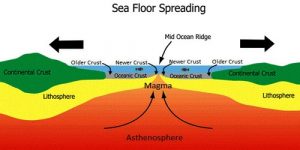What Is Seafloor Spreading?

According to a study that analyzed data from the last 19 million years, Seafloor spreading rates have slowed down by roughly 35% globally.
- For this study, researchers selected 18 of the world’s largest spreading ridges (mid-ocean ridges).
- A ridge or a mountain ridge is a geographical feature consisting of a chain of mountains or hills that form a continuous elevated crest for an extended distance.
- By studying magnetic records in the rocks on the oceanic crust, they calculated how much oceanic crust had formed over the last 19 million years.
- Basalt rocks on the oceanic crust contain magnetic properties.
- Their magnetism is influenced by the Earth’s magnetic field when the magma reaches the surface and begins cooling to form the crust.
- But the records are incomplete because the crusts get destroyed at subduction zones.
- Subduction zone is a point where two tectonic plates collide, causing one of them to sink into the Earth’s mantle beneath the other plate.
- The seafloor spreading hypothesis was proposed by the American geophysicist Harry H. Hess in 1960.
- Seafloor spreading is the process of magma welling up in the rift as the old crust pulls itself in opposite directions.
- Cold seawater cools the magma, creating a new crust.
- The upward movement and eventual cooling of this magma has created high ridges on the ocean floor over millions of years.
- However, the seafloor is destroyed in subduction zones, where oceanic crust slides under continents and sinks back into the mantle, and is reforged at seafloor spreading ridges.
- The East Pacific Rise is a site of major seafloor spreading in the Ring of Fire.
- It is located on the divergent boundary of the Pacific Plate, the Cocos Plate (west of Central America), the Nazca Plate (west of South America), the North-American Plate and the Antarctic Plate.




